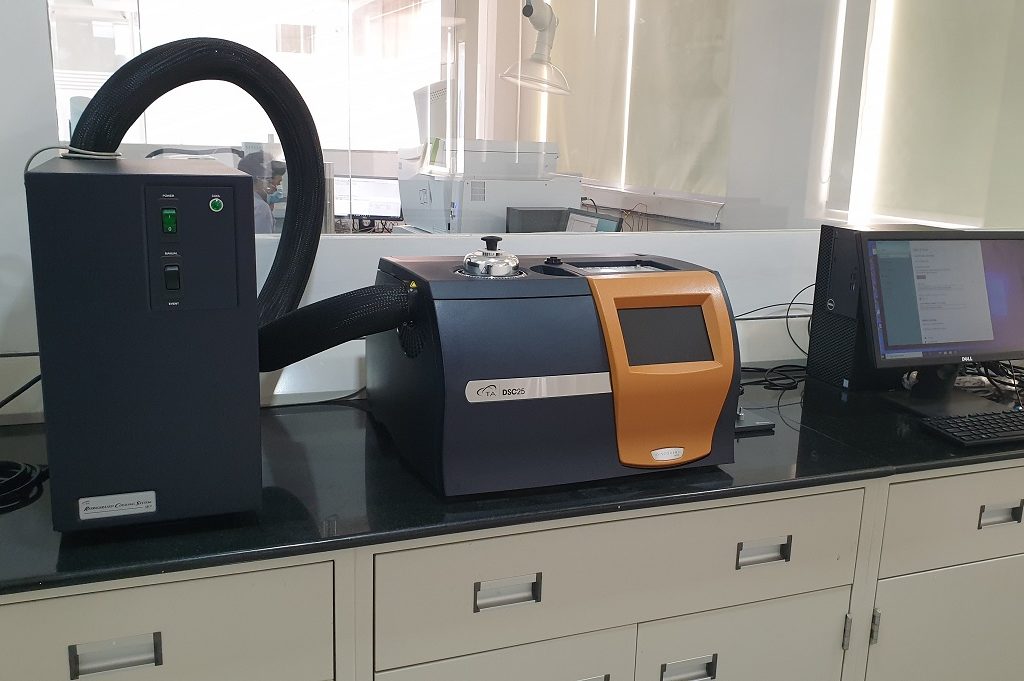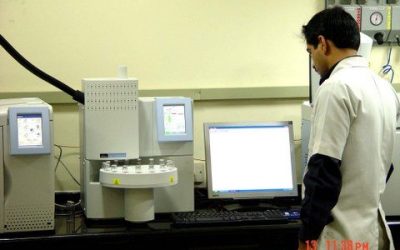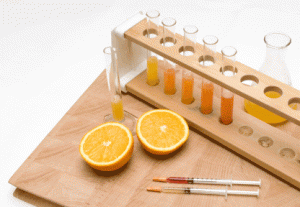
Differential Scanning Calorimetry (DSC), is an undemanding and effective technique, utilized for examining the thermodynamic properties of thermally induced transitions. The technique was developed by E.S.Watson and M.J. O’Neill in 1962 and was commercially introduced in 1963.
With the recent technological advancements, the extent of DSC application has increased. DSC is being applied for studying excipients, active pharmaceutical ingredients (APIs), lipid-based drug delivery systems, polymorphism, biopolymer melting, DNA binding to a protein, lipid-protein interactions, lipid carriers, and a lot more.
Besides, the scope of DSC is not only bound in the pharma field just for drugs, it finds its application in the cosmetics, medical devices, and also the food industry.
The main aim behind DSC is to study phase transitions.
DSC is based on the principle to maintain a zero temperature difference between the sample and reference material while they are being heated by separate heaters. During heating, these temperatures are increased or decreased linearly and endothermic-exothermic reaction can take place.
Recent advancements in the technical field, have also contributed to making DSC compatible with studying the thermodynamic properties of various pharmaceutical products, such as biopolymers, proteins, peptides, and lipid carriers.
Interpretation of DSC Curve
The DSC experiment carried results in providing a curve of heat flux (per time unit) versus temperature either versus time as shown below:

When a substance comes in contact with heat, then either the heat is provided to the substance or taken away from it. These changes are depicted in the typical DSC curve shown below:
There are two conventions: exothermic and endothermic. These endothermic and exothermic peaks in the DSC graph recorded results from the temperature differences between a tested sample and a reference sample, showing negative or positive deviations from the baseline.
The above graph is useful in calculating enthalpies of transitions which can be expressed as the following equation:
ΔH = KA
Here, H represents enthalpy of transition,
K represents calorimetric constant (varies from instrument to instrument), and
A represents the area under the curve
Various changes by DSC in substances
Endothermic events: If heat is absorbed by the sample during phase transition, then the reaction is endothermic.
Examples are: Melting, boiling, sublimation, desolvation chemical reactions
Exothermic events: During the phase transition, if the sample is releasing heat, then the reaction is endothermic.
Example: Degradation, crystallization
Glass Transition: The glass transition is a physical state conversion in which an amorphous polymer changes from a hard, brittle substance to a soft, rubbery substance.
The glass transition temperature is represented as Tg.
A typical example of a heat flow versus temperature plot at a glass transition temperature is depicted below:
Factors affecting DSC Curve

Types of DSC Instrument
Five different types:
- Heat flux DSC
- Power compensated DSC
- Modulated DSC
- Hyper DSC
- Pressure DSC
Application in Food and Pharma Industry
Food Applications of DSC
- Oils, fats and spreads: The heat-cool-heat DSC program is used to determine the onset temperature, the heat of fusion (ΔH), the identification of polymorphic behavior, oxidation stability, and crystallization of oils and fats.
- DSC of Flour and Rice starch: Retrogradation, gelatinization, and glass transition of starch samples are analyzed.
- DSC of vegetable powders: Food products are complex mixtures of several compounds, so sometimes it is difficult to know about their glass transition (Tg) temperatures in which DSC is very useful.
- DSC of Proteins: Proteins denaturation of protein is intensively studied by DSC. For food proteins, the impacts of pH, salt, and polysaccharides are explored.
- DSC of Pastes and gels: Specific heat (Cp), onset temp of melt, and crystallization of pastes and gels consisting of polysaccharides or gums are determined.
- DSC of Milk Powders: Dry milk powders are subjected to many temperature changes while transportation. The thermal properties of the dry products are subjected to the composition, density, porosity, fat, and water content which are determined by DSC.
Pharmaceutical Applications of DSC
- As per a report, about 90% of the pharmaceutical products available are in the solid form (e.g., tablets). To ensure the quality of the products, the concentration and distribution of its components (APIs and Excipients) needs to be determined. The API may be of crystalline or amorphous solid state while the excipient can be solid, liquid, or gas. To make the API soluble and stable, different ways for dispersion are considered. For this, DSC is an excellent tool in characterizing solid dispersions. The correct determination of Tg helps in knowing about the proper storage conditions, therefore, avoiding phase transitions.
- The connection between the stability of dispersion and Tg is often used in the decision-making of the probable physical stability of amorphous systems (but difficult in the case of pure amorphous solids).
- Analysis of Crystallinity helps in maintaining the quality of materials from the raw form to the finalized products and also in the testing of technological procedures effectiveness. The changes in crystallinity are easily detected using DSC.
- Compatibility study of drug with excipient is of great importance in the pharmaceutical industry which is studied by DSC along with the help of X-ray diffraction and infrared spectroscopy.
- Drug–excipient interactions not only tell about several chemical reactions but also about other physicochemical changes such as the melting point that possibly can change the effect of API.
- Useful in studying tablet coating.
- Investigation of moisture content in drug and their purity profiles.
- One of the earliest applications of DSC is found in studying thermodynamic properties of the small proteins especially for those pharmaceutical products that come in the form of proteins (e.g., enzymes). DSC is also suitable for learning about the thermal stability of photosensitive proteins.
- For analyzing the incorporation of drugs into nanoparticles through enthalpy change, Thermal analysis (DSC) is useful.
DSC is also useful in analyzing stability and drug dissolution from nanostructured lipid carriers (NLC). - DSC can be considered as a quick screening tool to find out the effect of intercalating drugs on a nucleosome structure and also to study different mechanisms of DNA interaction.
DSC helps study in-vitro interactions of antitumor drugs. Moreover, DNA-Drug interactions have also been studied through calorimetric data in the case of many Non-steroid anti-inflammatory drugs (NSAIDs).
- When it comes to novel peptide antibiotics, their design, development, and understanding of the molecular mechanisms depend upon the concept of peptide-lipid interactions. DSC provides a piece of quantitative information about the peptide-lipid interaction and also about the peptide effect on the membrane structure.
Previously DSC studies depicted there can be some kind of associations with the lipid components depending upon the antimicrobial peptide. This interaction may not be purely electrostatic.
- Likewise for tablets, DSC is needed during the preparation of cosmetics to develop and control the quality of raw, intermediate as well as the final product.
- DSC also finds its application in the pharmaceutical industry, during the development of surgical materials and clinical instruments.
- Many pharmaceutical materials demonstrate polymorphic behavior (substances may exist in several crystalline forms). DSC is useful in detecting and characterizing the different polymorphism of pharmaceuticals.
Other most important effects analyzed by DSC for medical devices and compounds include melting point, melting behavior, the heat of fusion, oxidation stability, purity, etc.
SOURCES:
-
https://pharmaperception.blogspot.com/2019/04/determining-conditions-for-primary.html
- https://www.slideshare.net/AmrutaBalekundri/thermal-technique-and-differential-scanning-calorimetry
- https://www.perkinelmer.com/lab-solutions/resources/docs/APP_DSC_Food_Applications.pdf
- https://www.slideshare.net/BHAVESH28/principle-and-application-of-dscdtaftir-and-x-ray-diffraction
- https://www.mdpi.com/2073-4360/12/1/5
- http://www.tainstruments.com/pdf/literature/TA302.pdf
















